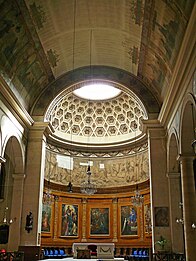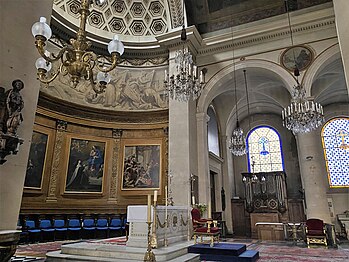Notre-Dame-de-Bonne-Nouvelle
| Notre-Dame-de-Bonne-Nouvelle | |
|---|---|
Île-de-France | |
| Rite | Roman |
| Status | Active |
| Location | |
| Location | 25 Rue de la Lune, 2nd arrondissement |
| Geographic coordinates | 48°52′10.5″N 2°20′59.5″E / 48.869583°N 2.349861°E |
| Architecture | |
| Style | Neoclassical |
| Groundbreaking | 1823 |
| Completed | 1830 |
| Official name: Notre-Dame de Bonne-Nouvelle | |
| Designated | 1983 |
| Reference no. | PA00086016[1] |
| Denomination | Église |
Notre-Dame-de-Bonne-Nouvelle, located at 25 Rue de la Lune, in
History
The first chapel was built on the site in 1551, originally dedicated to Saint Louis and Saint Barbara, then rededicated to the Bonne Nouvelle, or the Annunciation of the coming of Christ. This first church was destroyed 1591 by the Catholic League during the siege of Paris by the future Henry IV. Queen Anne of Austria laid the first stone of a new church in 1628. During the French Revolution, the building was badly damaged and in 1823 finally had to be pulled down.[3]
The new church was built between 1823 and 1830 by the architect Étienne-Hippolyte Godde in the neoclassical style, which was very popular following the Restoration of the French Monarchy. [4]
Exterior
-
West side of the church
-
Facade of the church
-
Bell tower (17th c.)_
The facade of the church, facing north, is modelled after an ancient Roman basilica, with two Doric order columns forming a peristyle over the porch. The bell tower is the only surviving vestige of the earlier 17th-century exterior.
Interior
-
Nave and choir
-
The dome and the choir
-
The choir and the organ
Since the church is surrounded by other taller buildings, the interior of the church is dimly lit. The altar, beneath the dome, is lit by a skylight and three chandeliers. The nave and choir are lined with rows of Doric columns creating arcades with rounded arches.
-
The Baptismal Font
-
Decoration of the Baptismal Font - Saint James.
The most distinctive feature of the interior is the large octagonal
Art and decoration
-
"The Virgin surrounded by the Saints" (right), byLudovico Cardi
The choir of the church displays paintings by three notable Baroque artists from the 16th and 17th centuries.
- "The Annunciation" by Giovanni Lanfranco (1582-1647) of Parma, ar vivid Baroque display of skill with darkness and light, and tones of red and orange, around the figures of the Virgin Mary and the Angel Gabriel.
- "The satisfaction of Isabel of France" by Louis IX, or Saint Louis, featuring the figures of Isabel and the against a background of the Paris cityscape.
- "The Virgin Surrounded by the Saints" by
- A notable 19th century work with a Parisian theme is found in the lower left aisle: "Saint Genevieve distributing bread to the Parisians", by Jean-Victor Schnetz (1787-1870)[7]
Organ
The church organ was built by John Abbey at the end of the 19th century, then was restored in 1950 by Joseph Gutschenritter, and again in 1988 by Jean-Marc Cicchero.
Bibliography
- Dumoulin, Aline; Alexandra Ardisson; Jérôme Maingard; Murielle Antonello (2017). Paris d'église en église (in French). Paris: Éditions Massin, collection Reconnaître. ISBN 2-7072-0583-4.
Notes and citations
See also
External links
- [1] Web site of the church










